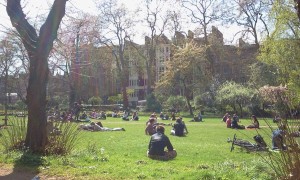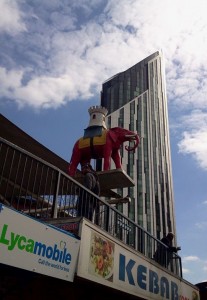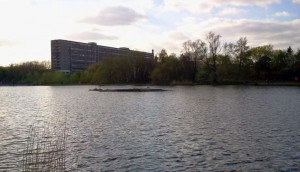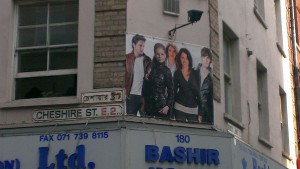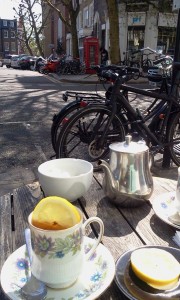London happens to make an excellent escape for spring each time. When spring comes, people hurry to wear summer clothes, which always looks really extreme to my eyes. It reminded me of Gothenburg in many ways. People seem to appreciate every sunny day.
This time I went to explore London’s areas that I hadn’t visited before, and experience more of its cultural life.
There are several London Tube stations that I notice on the map, because they sound like indie bands. One of them is Elephant and Castle, and I finally saw where it comes from – there is an elephant with a castle (not that it makes any sense, but I’ve stopped searching for logic after my first trip to the UK).
This area is interesting and very green. I spent a few hours in Burgess Park, where people enjoy walking, cycling, roller skating, skateboarding, using its exercising facilities and even fishing in a pond. Apparently the park recently received investment from the municipality for redevelopment. In some ways it reminded me of the park I used to go to in South Tel Aviv, perhaps because of the exercising equipment and the general atmosphere.
In addition to this area, I went to explore one of the trendy areas of East London – Brick Lane. My friend B. took me there to show some graffiti, which is interesting even for a long-time Londoner to see, because they always change. We saw many tourists in the area, taking pictures of street art objects, big and small. I had been to the area, but I had never seen tourists there.
The neighborhood is still somewhat Bangladeshi, although gentrification is rapidly changing its character. It is interesting how this is visually manifested:
Walking there, we were suddenly invited to visit a gallery on one of the streets that we passed. It is run by artists themselves. We saw the works first and then talked to another employee at the gallery. We tried to guess which of the works were hers.
In fact, I saw quite a bit of art this time. I saw an exhibition of prisoners’ art at King’s Place (on York Way), where paintings and drawings of male prisoners, serving their prison sentences for particularly serious crimes, were produced in cooperation with a professional artist, who got an artist residence to work with them. There were some stories and comments from the prisoners, written next to the paintings or in the exhibition’s booklet. One of the prisoners made a remark that nobody was ever interested in his artistic capabilities before he was imprisoned. Another one appreciated that his hands, which previously caused pain, could now be put to good use and produce something beautiful.
In addition, my new friend L. took me to the Wellcome Trust, which gathers various materials, models and art works related to the human body and medicine. Since the museum is currently undergoing reconstruction, we could only see its permanent exhibition, with a loudly shutting metal eye, various interactive exhibits for children, and a sculpture of a person as a lump of fat. At some point one of the employees brought a covered tray and asked visitors to touch objects under the cover and guess what they were. It turned out that what he had was a couple of prosthetic limbs and plastic/silicon (?) copies of Amazonian shrunken heads. He then explained how prosthetic limbs were made, why they were made smaller than original limbs and what shrunken heads were for. In fact, I had seen a real shrunken head of a human and a monkey at the Musée du Cinquantenaire in Brussels, and I wondered how these were made. The employee of the Wellcome Trust explained that the secret was removing the tissues from the bone. Colonists were so fascinated by the Amazonian shrunken heads, he said, that they would happily trade them for guns until there was a shortage of these objects (historically used for ritual purposes), so the acquired guns came handy for hunting more humans to produce more heads. I was quite surprised that the museum staff was telling this story to primary-school-aged children.
After the mini tour we went to The Invisible Dot, a small venue for events, where we went to see stand-up comedy. This was the first time I saw an English stand-up comedy show. This is a popular phenomenon in Lithuania now, and I saw some people, who started as amateurs, becoming famous and actually touring the UK to perform for Lithuanian migrant workers. The show (the Saturday Night Show) we went to see consisted of a sort of host enveloping the other performances with his witty everyday life stories (I remember his jokes about turning 30, about the concept of ‘being nice’, and the low expectations of today’s movies, when people say ‘watchable’ as a compliment – I found them trans-culturally well-translatable) and two ‘guests’, one of whom spoke with an American accent and played an amateur comedian. Overall, the comedy was fun, and I could relate to more of the cultural content than I expected.
The last cup of tea with B. before it’s time to head to the airport.
For those of you who read Lithuanian, here is an essay born from this year’s trip to London.


